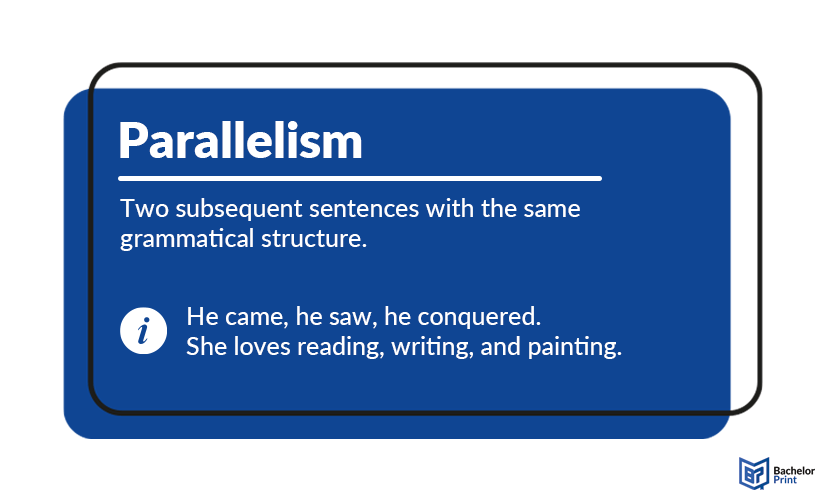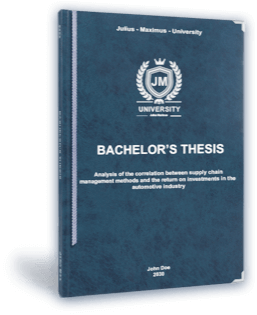
Stylistic devices can elevate, polish, and improve your writing. Although many figures of speech are uncommon in academic writing, there are a few you can include. One of them is the parallelism, characterized by a parallel structure of grammar in a sentence. The following article will cover all relevant information about this rhetorical device and visualize it with various examples.
Definition: Parallelism
The most important thing for parallelisms is, of course, the parallel grammatical structure of the sentences or parts of the sentences. Usually in literature, the whole subject-verb-object complex is repeated with different words, but you can also repeat only one type of word. The following examples will clarify this.
In the first sentence, we have the subject “he,” the verb “wanted to,” and the object “stay,” followed by the subject “she,” the verb “wanted to,” and the object “leave.” The whole sentence structure is repeated. The second example is different because only the object is repeated.

- ✓ 3D live preview of your individual configuration
- ✓ Free express delivery for every single purchase
- ✓ Top-notch bindings with customised embossing

Use & purpose
Parallelism can have many intentions, like emphasizing, comparing, or simply impressing with literary know-how. One important thing, however, is that the sentences or parts need to be logically connected; otherwise, the reader will only end up confused.
For emphasis, you often repeat just one type of word from the sentence, or you make only minor changes to the second sentence to avoid repetition.
A parallelism can also be used to highlight a comparison or contrast, making it easier to see due to the similar sentence structure.
Especially in speeches, parallelism is typically used in combination with an anaphora. This is the case because the parallel structure invites you to not only repeat the grammar but also the words themselves and emphasize the subject as well.
Mistakes
Various mistakes can happen when you try to create parallelism. Therefore, this list of possible mistakes can help you to check if you used the stylistic device correctly.
The most common mistake happens when you form a seemingly parallel-structured sentence but use different verb forms. This applies especially when you mix up gerunds, infinitive forms, and conjugated verbs, but also to different times. If you use two or more different times, it depends on the context, but most likely the logical link does not exist then.
Another point to watch out for is whether you are using singular or plural nouns, as you should stick with one option. If you choose plural, however, the number is not relevant anymore, as the following examples will show.
Furthermore, take notice of the word types you are using because they should all belong to the same class. Do not mix up nouns, adjectives, verbs, and adverbs.
Although it is not strictly necessary, when a sentence structure is repeated after “because,” it is best to repeat the adverbial conjunction for clarity.
Examples
The following paragraphs will present various examples taken from different types of writing.
When it comes to literary devices, the first thing that comes to mind is always literature itself. Every author uses them to elevate their text and make it more entertaining for the reader. The parallelism is no exception and is thus found in many famous and infamous books.
Since parallelism is a very catchy rhetoric device, it is also often used in speeches.
Song lyrics also often include various stylistic devices, and especially because parallelism is simple but impactful, there are many artists who use it in their music.
Differences from similar devices
There are a few other stylistic devices that can easily be confused. This mostly happens with chiasmus and antimetabole. The following paragraphs will describe the differences between them to help you keep them apart.
Chiasmus
Chiasmus could be called the opposite of a parallelism. It refers to two sentences with mirrored grammatical structure. In contrast to parallelism, the chiasmus is a little more extravagant and thus rarely used in academic writing. However, it finds application in literature as well as rhetoric.
In this example, you can see that the structure gets repeated after the semicolon. The sentences are basically the same, with just a few exchanged words.
In the case of the chiasmus, you can see that in the first sentence, the main clause comes before the conditional clause. In the following sentence, the order is reversed, beginning with the accessory clause and ending with the main one.
Antimetabole
Antimetabole is technically a type of parallelism. In this case, however, the same words are used and mirrored. Some people claim that an antimetabole is a type of chiasmus because of the mirrored words, while it also has the parallel sentence structure of parallelism. The definition is not entirely clear, and it can be considered a mixture of both of them.
The antimetabole could be considered the combination of chiasmus and parallelism. It has the parallel structure of the grammar but the cross structure of the words. In this case, the repeated structure is “In times of X, prepare for Y,” and only the words “peace” and “war” are exchanged.
Here, the words used are almost the same, and the sentence structure is parallel. First, the action comes after the subject and before the object “city.” In the additional clause, the action of losing herself comes in second place as well, setting the exact same grammatical order.
FAQs
Parallelism is a stylistic device where the structure of a sentence or one type of word in a sentence is repeated.
Examples
- They love to dance, sing, and have fun.
- She went out to water the flowers. He went out to wash the car.
Famous examples would be:
- “I came, I saw, I conquered.” – Julius Caesar
- “You’re hot, then you’re cold. You’re yes, then you’re no.” – Hot n cold by Katy Perry
- “I’ll give my jewels for a set of beads / my gorgeous palace for a hermitage / …” – Richard II by Shakespeare
While the parallelism copies the grammatical structure of a sentence, the chiasmus mirrors it.
- Parallelism: We do not need a fight; we need peace.
- Chiasmus: We do not need a fight; peace is what we need.